 At some point during your move, whether you need a box or two to throw some small knickknacks in or you’ve decided to pack everything yourself, you’re probably going to need to get your hands on some boxes. Since this elusive task can be harder than it seems, we’re here to help and share some tips on not only where to get boxes, but where to get the right ones. (And here’s what’s cool: if it’s all too much to deal with, Moveline can handle it for you completely.)
At some point during your move, whether you need a box or two to throw some small knickknacks in or you’ve decided to pack everything yourself, you’re probably going to need to get your hands on some boxes. Since this elusive task can be harder than it seems, we’re here to help and share some tips on not only where to get boxes, but where to get the right ones. (And here’s what’s cool: if it’s all too much to deal with, Moveline can handle it for you completely.)
Plan before you pack
Before you go box hunting, it’s important to know what kind of box you’re looking for because not all boxes are created equal. Box ratings are based on the results of an Edge Crush Test (ECT), which you can find stamped on the bottom of the box. Boxes range from 23 to 82 ECT; the higher the score, the sturdier the box.
Figuring out how much of your stuff requires high ECT boxes and how much will be just fine in less sturdy boxes is key. Breakable or fragile things and high-density items (like hardcover books and statues) belong in high ECT boxes. Things like linens and dry, uncanned food (you know, all that instant mac and cheese you bought at Costco) are ideal candidates for low ECT boxes — items that don’t have a high chance of being damaged by pressure from outside the box, but also won’t damage the box from the inside out either.
Boxes on the cheap
Thanks to the internet age, you might not have to go much farther than your computer to find free (or nearly free) boxes:
- Craigslist (under the “free” category of the For Sale / Wanted section)
- Rummage sales (check your local paper for announcements and addresses)
- Rumgr (an app that brings rummage sales to your smartphone)
- Liquor, grocery, and fast food stores (check out this Facebook group dedicated to the reuse of McDonald’s fry boxes)
- Shopping centers like Walmart, Lowes, and Home Depot
- U-haul’s Customer Connect
Getting the good stuff
For those items that need tougher boxes (or if you want to splurge on tougher boxes since there’s dinero left over after Moveline got you an awesome price on your move), head this way:
If you’re looking to make an eco-friendly move, check out rentable, reusable plastic bins from suppliers like Rent A Green Box, Uline’s eco friendly line, EZ Bins, Rent-a-Crate, Bungo Box, and Frogbox (just make sure the option you choose is available in the cities where you need them).
From acquiring boxes to finding the best solution for your move, Moveline is here to help. We get you guaranteed quotes (including boxes and packing materials if you don’t feel like tracking them down on your own), and we’ll stick with you the whole way, making sure your stuff is well taken care of and that your stress level stays as low as possible. Check out more about what Moveline can do for you here.
 Seattle, the crown jewel of the Pacific Northwest, is a city with lots of short-term housing opportunities. According to local realtor Ryan Halset, “Our economy was not hit as hard as other areas during the economic downturn, and companies such as Microsoft and Amazon have continued to hire. Temporary housing is a consistent need for people moving to the area… you’ll find that the cost of temporary housing is typically more than (that of) permanent, but it can be a great option while you learn about the unique neighborhoods of Seattle.” So, we’ve put together a handy primer on finding short-term housing in the Seattle area — Washington State’s cultural epicenter.
Seattle, the crown jewel of the Pacific Northwest, is a city with lots of short-term housing opportunities. According to local realtor Ryan Halset, “Our economy was not hit as hard as other areas during the economic downturn, and companies such as Microsoft and Amazon have continued to hire. Temporary housing is a consistent need for people moving to the area… you’ll find that the cost of temporary housing is typically more than (that of) permanent, but it can be a great option while you learn about the unique neighborhoods of Seattle.” So, we’ve put together a handy primer on finding short-term housing in the Seattle area — Washington State’s cultural epicenter.
Start your search by checking out Moveline’s own guide for new Seattle residents. The first section, with its profiles of the city’s neighborhoods, will give you a head start. Two other great sources for orienting you to the city from afar are Trover.com and COEverywhere.com. Trover, the brainchild of Seattle resident Jason Karas, let’s you see photos of what people who live in Seattle like best — coffee shops, galleries, and all kinds of cool places to go, while COEverywhere connects you to the social activity going on in the location of your choice, linking to tweets, Facebook posts, photos, Groupon deals, and more for any neighborhood you click on the site’s map.
To get a feel for what the real estate market is like in Seattle, check out Curbed.
Now that you’re acclimated, there’s nothing better than word of mouth and personal references from friends, relatives or colleagues when you’re looking for short-term accommodation. Failing that, though, you’ve got plenty of alternatives.
The old stand-bys
You probably already know about Craigslist and Airbnb; indeed, both sites are good starting points for your search. A recent check of those sites came up with a furnished studio with a kitchenette one block from the Space Needle for $1695 on Craigslist, and a hilltop condo with one bedroom in the Queen Anne neighborhood for $2575 per month on Airbnb.
Sublets
Plenty of national sites exist to help you find temporary housing in cities like Seattle Oodle, Hotpads and Ebay classifieds, to name a few — but don’t overlook the local sources, which can help you find hidden gems. Sea to Sky Rentals got its start when the founder decided to sublet an apartment in her own home and recognized it was something that others would want to do, too. Two other locally owned and operated sites are Short-Term Suites, promising postings twice a day, and Seattle Furnished Suites, where a 550-square-foot one bedroom in the “hip & nerdy” Ballard neighborhood was listed for $1395 per month.
Uloop is an ideal source for sublets located near colleges and university campuses — just search by the name of the school you want to be near. And although Live Lovely is primarily for longer term rentals, you can try “month-to-month,” “short-term” or “corporate housing” in the site’s search feature and see what pops up in your range.
Roommates
If you’re okay with sharing space with someone else, try Roomster, Roommates.com and Roomie Match. Roomster has a category called “entire property search” as well if sharing isn’t your thing. On it we recently found a 1 bedroom, one bath with parking included for $750 per month. (And if you need tips on getting along with roommates, we’ve got you covered.)
Corporate housing
There’s no shortage of corporate housing companies with properties to offer in Seattle. This option is typically the most expensive since the accommodations are usually in high-end buildings that offer lots of come-hither amenities like gyms and swimming pools and, in the case of Synergy, even special arrangements for those furry friends on four legs.
If you aren’t bargain hunting and want a one-stop shopping experience, check out the Seattle listings on Aboda, Oakwood, Bridgestreet or Execustay. An Oakwood listing for a one bedroom in a highrise located where Belltown meets Downtown is $176 per night. Monthly rates are available for what promises to be a “vertical neighborhood” with everything you need right in the building, including a movie and game room.
Vacation Rentals
Lots of sites can connect you with a space that the owner wants to rent for a day, a week, a month or longer. Airbnb is exactly that kind of site, and its competitors include Vrbo, Flipkey and HomeAway.
A local vacation rental site, Seattle City Rentals, may have a few nice choices as well; a recent search showed an apartment in a building with five one-bedroom apartments ($650 to 975 per week depending on season) and a stand-alone cottage next door with a bedroom, space for an office and a secluded back patio ($750-$1200 per week).
No matter what route you choose, you’re bound to find something that suits you. Whether you’re moving to Seattle for a short-term stay or a longer haul and just need temporary housing while you get your footing, there’s a home out there with your name on it. And once you find it, let Moveline help you get there. We’ll compare prices on your behalf, get you connected with the right moving services, and have your back every step of the way. Saving money, time, and stress is definitely the way to go, so give us a shout and let us help you get a move on.
 As with most things in life, a successful move begins before the trucks arrive. Smart organizing and packing makes moving easier and more efficient. And while hiring a professional packing team can be a great decision, it doesn’t mean you’re totally off the hook. After all, it’s your stuff that’s at stake!
As with most things in life, a successful move begins before the trucks arrive. Smart organizing and packing makes moving easier and more efficient. And while hiring a professional packing team can be a great decision, it doesn’t mean you’re totally off the hook. After all, it’s your stuff that’s at stake!
Beyond using your own common sense, the following tips will help ensure that the things you value so much end up intact and in the right spot in your new home.
- Clean and organize. Laundry, dishes, tools and other items pack and move easier when they’re not a mess.
- Purge! Go through and pull stuff that you can trash, give away or donate. Remove these items before the packers arrive, or gather it all into one pile and clearly mark it “DO NOT MOVE!”
- Pull items that you’ll move yourself. These normally include medicines/toiletries, enough clothing for the move duration, personal items (electronics/chargers/books), work stuff, jewelry and hazardous items that packers and movers won’t touch. Pack these things ahead of time, or clearly mark them.
- Organize and label rooms. Have all your master bathroom items in your master bathroom, for example, and use signs to mark every room so the packers can mark boxes accordingly. If a large item will switch rooms in the new house, just mark it with its own label.
- Back it up. Use portable hard drives (that you keep with you) or cloud storage to back up any important computers, tablets, etc.
- Mark high-value items as such. Whether it’s a truly valuable vintage record player, or an old music box that has more sentimental value than collector value, this tells packers and movers to take extra care with these items.
- De-clutter. Packing moves faster if the team has surfaces to work on (tables, countertops, etc.) that are clean and open.
- Walk the walk & talk the talk. Tell the packing team your expectations and make sure you’re available if they have questions. Walk through your home before and after the packing job and make sure it’s all done to your satisfaction.
- Prepare for a snack attack. Everyone loves snacks. Have some cold water or lemonade and some cookies or granola bars available to the packing team. Warm chocolate chip cookies earn extra points.
Put in a little legwork ahead of time and you’ll avoid spending the first year in your new home trying to figure out how the can opener ended up with the gardening supplies. For more tips, check out the endless well of helpful articles that is the Moveline blog. And when you’re ready to book your move, don’t go it alone. Give us a shout. We’ll be there with you every step of the way.
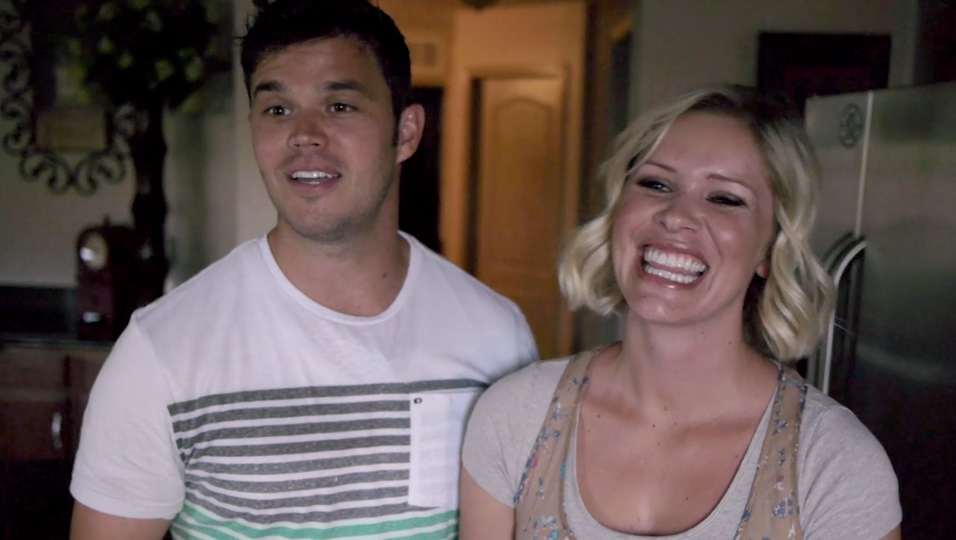 It’s true what they say: opposites attract. But when those opposites are thrown into the life-changing tumult of, say, a cross-country move, an uninvited third wheel can weasel its way into the relationship, and that third wheel’s name is Stress. In the case of one particular husband and wife who recently moved from Arizona to Pennsylvania, their fundamental differences — his wanderlust and her love of staying in one place — were just the first of several sticking points when he got into a dental school that required them to move thousands of miles away. Luckily for them, here at Moveline we’ve helped our fair share of folks move from one place to another, and making relocation easier for couples is one of the many services we offer.
It’s true what they say: opposites attract. But when those opposites are thrown into the life-changing tumult of, say, a cross-country move, an uninvited third wheel can weasel its way into the relationship, and that third wheel’s name is Stress. In the case of one particular husband and wife who recently moved from Arizona to Pennsylvania, their fundamental differences — his wanderlust and her love of staying in one place — were just the first of several sticking points when he got into a dental school that required them to move thousands of miles away. Luckily for them, here at Moveline we’ve helped our fair share of folks move from one place to another, and making relocation easier for couples is one of the many services we offer.
“We tackle things a little bit differently,” she explains. “So for the move, he was thinking, ‘Oh, it’s not gonna be that bad, and I don’t think moving cross-country will require much work, and I think we should do it ourselves,” and I just thought, ‘This is going to be a disaster if we do it ourselves.’”
Not knowing a soul in their soon-to-be adopted city of Pittsburgh, they put their fears aside and dove headfirst into planning the move. Step one: engaging Moveline’s services. With the help of their mover, they got a firm grip on whether or not to hire a mover (verdict: yes) and which things to keep vs. which things to toss before the move, not to mention a great deal on a moving company that saved them not just money, but also quite a few disagreements. And that, of course, is a priceless thing when you’re taking a rather literal leap of faith all the way across the country to an unfamiliar place.
The bottom line, according to our two new Pennsylvanians? “Moveline saves marriages! Just joking. But it sure reduces stress, and the what-ifs of (moving) out there.”
 Packing your stuff yourself is an excellent way to avoid costs when moving, but if you’re taking a DIY approach, the single most important thing to know is what not to pack. Moving professionals are trained to look for normal household items that are actually hazardous and often illegal to ship. Being proactive in the planning process can eliminate the risk for potential surprises (not the good kind) and save time along the way. Because no one wants their moving day to end up in disaster.
Packing your stuff yourself is an excellent way to avoid costs when moving, but if you’re taking a DIY approach, the single most important thing to know is what not to pack. Moving professionals are trained to look for normal household items that are actually hazardous and often illegal to ship. Being proactive in the planning process can eliminate the risk for potential surprises (not the good kind) and save time along the way. Because no one wants their moving day to end up in disaster.
Know what not to pack
Your moving company should provide you with a list of “non-allowables,” an industry term for things professional movers won’t transport. The list not only includes intuitive items like ammunition and gasoline (truck fires are frowned upon), but also less-obvious things such as nail polish and toy chemistry sets.
Below is a list of some of the most common non-allowables, but you can check out a full list here. You might notice that alcohol is included… if you ask us, that’s a perfect excuse to invite all your friends over and throw yourself a little going away shindig.
Think “out of the box” – literally:
- Aerosol cans (regardless of content)
- Flammables (like Sterno, charcoal, lighter fluid, matches, and lighters)
- Nail polish and remover
- Fire extinguishers
- Alcohol
- Any type of gas in bottles or tanks (including propane or oxygen)
- Paints, varnishes, solvents, thinners and oils
- Household cleaners (like ammonia and bleach)
- Batteries
- Ammunition
- Fertilizers and pesticides
Food for thought
Here’s a piece of trivia you probably didn’t know: although they’re not hazardous, perishable foods and plants also pop up on moving companies’ things-not-to-pack list. Even though they’re not flammable or toxic, they can attract bugs, rats, and other pests that could damage your property — zero fun for anyone. Common perishables are things like:
- Frozen or refrigerated food
- Produce
- Open food items
- Plants (indoor and outdoor)
- Fresh herbs
- Flowers
Feel terrible throwing away food, though? No worries; consider donating those perishables to a group like Move For Hunger or a local shelter, soup kitchen, place of worship or safe house.
What to keep handy
Now that you know what you can’t pack, it’s time to think about what you probably shouldn’t pack. We recommend you keep personal items (things like daily necessities, items of sentimental value, and important documents) off of moving trucks as well. It’s kind of like the difference between carry-on and checked baggage when flying: anything that you use on the daily or anything that would be inconvenient at best (or heartbreaking at worst) to lose should probably go with you. Things like:
- Prescription medications
- Stocks, bonds and securities
- Identification documents (birth certificate, social security card, etc.)
- Collections (such as coins and stamps)
- Insurance policies
- Currency
- Jewelry and furs
It’s not a bad idea to put together a moving-in kit of the sorts of things you’ll need for the first night or two in the new place, regardless of how quickly you unpack. Check out our list of 10 essentials here.
Of course, it’s likely that you’ll still have to slate some things of personal value for transport on the moving truck. Fitting grandma’s vintage armoire into your Fiat? Probably not gonna happen. This is a good time to start thinking about moving insurance; luckily, our moving insurance primer is the perfect place to start.
Whichever way you chose to move — insurance or no insurance — don’t go it alone; let Moveline help. We’ll make sure you get from point A to B with as little stress as possible. Learn about our services, connect with a mover, and get started on your move today.
 Los Angeles, put simply, is huge. In square miles, it’s approximately the same size as New York City, but it has half the number of people and many, many more neighborhoods than Big Apple. Curbed LA, a popular real estate blog for the city, lists 108 neighborhoods; Curbed NY lists 60. And even those claims might be underplaying LA’s breadth: the LA Times lists a whopping 158 neighborhoods in the City of Angels. It’s no surprise, then, that a car is pretty much required in LA — but the good news is that virtually all rental properties come with free parking. At Moveline, we’ve helped plenty of folks move to a new city, and we know it’s often wise to take your time before putting down permanent roots or even signing a year-long lease. So, we’ve done a little digging to help you get your feet wet in LA before you dive all the way into the surf.
Los Angeles, put simply, is huge. In square miles, it’s approximately the same size as New York City, but it has half the number of people and many, many more neighborhoods than Big Apple. Curbed LA, a popular real estate blog for the city, lists 108 neighborhoods; Curbed NY lists 60. And even those claims might be underplaying LA’s breadth: the LA Times lists a whopping 158 neighborhoods in the City of Angels. It’s no surprise, then, that a car is pretty much required in LA — but the good news is that virtually all rental properties come with free parking. At Moveline, we’ve helped plenty of folks move to a new city, and we know it’s often wise to take your time before putting down permanent roots or even signing a year-long lease. So, we’ve done a little digging to help you get your feet wet in LA before you dive all the way into the surf.
For recommendations on some of the hottest LA neighborhoods, we talked to Karen Lower, who’s been a real estate broker in LA for ten years. “When I moved to LA as an East Coast transplant, I didn’t want to live in an isolated suburb. I wanted a real neighborhood right in the city,” she says. Her choice was Silver Lake on the east side (at that time, Venice Beach was the hottest neighborhood around) and she tells us it was a great choice: “Silver Lake is considered one of the hottest neighborhoods in LA right now.” Proof? Forbes named it the #1 hipster neighborhood in the U.S., citing its food trucks, farmers’ markets and booming art scene. One of the great attractions of the neighborhood is Griffith Park, where there are miles of hiking trails and a good view of the world-famous Hollywood sign from the parking lot of the observatory.
Clearly an East LA fan, Karen also recommends the adjacent neighborhood of Los Feliz. “Los Feliz means “the happy” in Spanish and in a city like LA where people drive everywhere, being able to walk to the market or to the bistro makes the residents of this thriving community very happy indeed.” Nearby Echo Park is another recent favorite because of its architectural gems: “The hills are speckled with mid-century homes designed by Richard Neutra,” Karen says. “Echo Park lake just had a multi-million dollar redo, the paddle boats are back and the lotus garden is looking beautiful.”
Some folks might prefer to live in Downtown LA. This is the piece of the city that looks the most like a big city and has grown exponentially over the past 15 years with the Staples Center and lofts just walking distance from some pretty great nightlife. In fact, GQ kicked off 2014 by declaring Downtown LA “America’s next great city” — a new capital of cool.
On the other hand, if you want to be guided instead by the folks who voted in Curbed LA’s Curbed Cup Competition for the neighborhood of the year, you’d consider living in Glendale. It beat out 15 other communities in the competition based on neighborhood growth and development in real estate, retail and restaurants.
Short-term housing standbys
Unless you’ve been living on a desert island for the last decade, you know all about Airbnb and Craigslist. Airbnb helps you decide on a neighborhood by giving you a checklist of things you might be looking for (artsy, lots of cultural events, nightlife, etc.) and then shows you properties that fit your requirements. A recent Airbnb listing for LA was a room in an early craftsman style house in Highland Park, one of the city’s historic preservation overlay zones, with a backyard and garden and “liberal parking,” all for $1298.
You’ll probably want to stay away from what Curbed LA calls “the 5 places that you always, always meet on Craigslist” and any of the “4 terrible rooming situations” on the popular site. An example of the latter is one posted by a horror mogul who says he’s looking for an “attractive 18-35 year old” who would enjoy what he calls “the coolest collection of Chucky puppets and props in the world.” Um, yikes.
A much more appealing recent offer on Craigslist offered a two month sublet of a large one bedroom apartment near the Grove and the LA County Museum of Art — “perfect for actors in town for pilot season”, $2200 per month.
LA sublets
A popular local source for rentals is WestsideRentals.com, where landlords list what they have available in the LA area. Most listings are for full-time rentals, but some sublets and rooms in houses or apartments are available by the month. One we found is a light and airy studio (four big windows with blackout shades for sleeping in) in the quiet, hillside neighborhood of Echo Park for $2100 per month.
SubleaseHub.com, another local source, lists short-term rentals like this one: a room in a large house in Central Hollywood with a front and backyard and “plenty of free parking” for $600, plus $50 for utilities.
A daily property alert service designed primarily to help you find long-term rentals but that can be useful for a short-term stay as well is LiveLovely.com. According to Elizabeth Pietrzak, who does communications and marketing for the California-based site, “Renters can use the keyword search filter on Lovely to identify listings where the owner or manager has indicated short term leasing options in the listing description. Recommended keywords are “short term,” “month-to-month” or “corporate housing.” She gave the example of a two-bedroom, one-bath duplex in West Hollywood with a large patio for $2995.
If you want to be near a college campus, check out Uloop.com, a one-stop source for apartments to sublet as well as roommate shares. A summer sublet in a balcony bedroom in a 1200 square foot apartment that’s 5 minutes away from UCLA’s Bruin Walk is listed at $700 per month.
Check out Oodle, Hotpads and eBay classifieds — all national websites with LA listings.
LA roommates
Start by using your own social media network. Ask friends and relatives and friends of friends and friends of relatives whether they know of anyone who would like to share space. A personal reference is always the most reliable way to find a roommate. If that route doesn’t work, there are a number of national sites set up to match you with a roommate. RoomieMatch, Roomster, Roommates.com and Uloop (again, for properties close to colleges) are good places to start.
LA corporate housing
This category is usually the most expensive but it’s the one that takes the least effort. The biggies in this category — ExecuStay, Oakwood, and Bridgestreet will be more than happy to set you up in a fully-equipped apartment that is near your work. An Oakwood one-bedroom at 1010 Wilshire listed at $147 per night will put you minutes from the Staples Center and Walt Disney Concert Hall and offer building amenities including a gym, health spa, rooftop pool, theater room and rooftop fireside lounge.
Another corporate housing behemoth wants to make your four-legged friend just as comfortable as you are at its properties. Synergy Housing offers Paws on the Property, a welcome package to ease your pet’s transition to its new home.
LA vacation rentals
The biggies in the field are VRBO, HomeAway and CyberRentals. Another option, less widely known, is Sabbatical Homes, a site created by the wife of a professor who turned her own search for a place to stay during a sabbatical into a business. The website also lists home swaps, house-sitting opportunities and a few shares. A sample property listed on the site is a two-bedroom cottage in LA described as “traditional, chic and updated” with a backyard fruits and vegetables garden for $2276 per month.
If you want an entire house and money is no object, there are always listings like the newly-built two-story housein Brentwood on LoveHomeSwap.com boasting a pool, outdoor jacuzzi and steam room (perfect for entertaining your new LA friends, naturally) at $3000 per week. Yes, week.
Whether you’re moving to LA or anywhere else, Moveline can help. By simplifying the inventory process, comparing quotes from reputable movers and having your back every step of the way, we offer guidance on all things moving-related and save you money, time and sanity — the most precious resource of all when you’re moving from one place to another. So don’t go it alone… let us help you #movebetter.
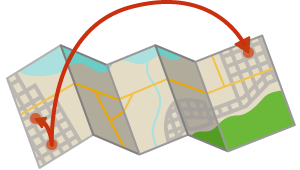 Lots of things about moving are kind of a drag. Financial strains, logistical concerns and the plain old act of uprooting oneself to a new home are all stressful enough on their own, but add to that the element of long-distance and you’ve got the makings of an ulcer on your hands. Right? Wrong. While Moveline works to decompress the frustrations typically associated with moving by saving people money, time and confusion, we also have a few tricks up our sleeves when it comes to turning a cross-country move more fun.
Lots of things about moving are kind of a drag. Financial strains, logistical concerns and the plain old act of uprooting oneself to a new home are all stressful enough on their own, but add to that the element of long-distance and you’ve got the makings of an ulcer on your hands. Right? Wrong. While Moveline works to decompress the frustrations typically associated with moving by saving people money, time and confusion, we also have a few tricks up our sleeves when it comes to turning a cross-country move more fun.
To kick things off, we’ve got some tips for folks moving between the Midwest and the West Coast (via Route 66), but first things first: no matter where you’re moving to or from, here’s a heaping helping of tips to turn that frown upside down as you get ready to relocate.
Get familiar with your new city
Sure, anybody can Google “fun things to do in City X,” but for a truly unflinching look at the way locals view their own neighborhoods, Urbane offers city maps with an irreverent take on various parts of most large US cities. Wondering where to find “Dominican artsy hipster living” in Miami or “clean-cut homes and streets that seem Middle America” in New Orleans? Look no further. Most chambers of commerce provide plenty of socioeconomic information on the communities they represent, along with links to city guides and helpful information, and when you’ve exhausted things like local newspapers and alt weeklies, there’s always Lonely Planet, Frommer’s and Fodors — because listen, if your new city’s best restaurants and diversions have already been reviewed and categorized by the world’s most esteemed travel writers, why not take advantage of their research? And while you’re at it, you can map out some fun, touristy stops and side trips to enjoy on the way there.
Specifically, if you’re moving to Seattle or Las Vegas and looking for a super-comprehensive insider’s guide with tips on where to live, work, eat, shop and play, check out Moveline’s new resident guides specifically written for folks moving to either city (with more cities to come soon).
Make the road trip fun
If you’re driving your own car to your new city instead of having it shipped, the long haul doesn’t have to be a boring one, especially when it comes to food. No matter where you’re going, a handful of websites and apps can help you avoid the fast-food-and-truck-stop fare typically found along America’s highways and byways: try crowd favorites like Yelp, UrbanSpoon and Zagat, as well as FoodTripping, a health-conscious app for iPhone and Android users that specifically helps road trippers avoid the french fry trap.
Find new friends
No doubt about it; moving to a new town and starting your social life over from scratch can be daunting. But with a little chutzpah and a smidge of effort, you can have a support system full of comrades, confidantes and brunch buddies in no time flat. Check out our tips for developing a social network in a new city, and if you need even more inspiration to get out there and take a bite out of your new surroundings, this thoughtful post detailing 7 ways to make a new city feel like home might be just the thing you need.
No matter how far you’re moving (or even how close, for that matter), Moveline can take the sting out of the process by doing the dirty work for you. Gathering quotes on your behalf, making sure you get fair pricing that doesn’t change, giving advice on everything from packing to insurance, and sticking with you the whole way through — those are just a few of the ways we make your move as stress-free as possible. Check us out and see if we can’t delight you in one way or another as you open the next chapter of life’s big adventures.
 The average American living space is shrinking quite a bit now that the McMansions of the 1990s and early 2000s are less viable options for those who can’t afford huge houses, those who don’t want them anyway, and those who want to live near the center of everything instead of out in the suburbs. With rising interest in microapartments, off-grid living and everything in between, the small space movement (and what some might refer to as “living in New York”) is taking hold with no sign of slowing down any time soon. Here at Moveline, we’ve helped all sorts of people move all sorts of places, and we’ve got a few smart tips for maximizing a minimal amount of square footage.
The average American living space is shrinking quite a bit now that the McMansions of the 1990s and early 2000s are less viable options for those who can’t afford huge houses, those who don’t want them anyway, and those who want to live near the center of everything instead of out in the suburbs. With rising interest in microapartments, off-grid living and everything in between, the small space movement (and what some might refer to as “living in New York”) is taking hold with no sign of slowing down any time soon. Here at Moveline, we’ve helped all sorts of people move all sorts of places, and we’ve got a few smart tips for maximizing a minimal amount of square footage.
1. Optical illusions
A few key things to remember when it comes to making a small space look big: mirrors reflect light and make a room feel more expansive, light wall colors feel more spacious than dark ones, and you’ve got more wiggle room than you think when you’re planning your layout. Your first instinct might be to shove everything against the walls to make room for as much open floor space in the center as possible, but actually, that makes a room feel more claustrophobic than when pieces are placed where they’re most functional. A close, clustered sitting area feels more cozy than a couch and two chairs plastered against opposing walls, facing one another in a still-life showdown. Hang a mirror or two (or place a large one in a corner), let the light shine in, and have a little fun with color and pattern. Bigger isn’t better. Smarter is better.
2. Convertible furniture
It’s been said that necessity is the mother of invention, a point perfectly illustrated by that old small apartment standby: the futon. Couch by day, bed by night, it’s a staple of collegiate living, and lots of other furniture pieces take their cues from its versatility. If you’re willing to part with a little cash to make your space super-functional, consider investing in a workspace that becomes a bed, an office trunk that opens & closes, or even the simple wonder of a fold-out desk that expands and contracts as you need it to. Especially for those of us who work from home and savor our sanity, a little ingenuity goes a long way.
3. Small-space gadgets
As living spaces get smaller, simpler and less wasteful, so do the gadgets that help us live our lives. If you don’t have space for a washer/dryer but hate the thought of dealing with a laundromat every time you need a few things washed, there’s the Laundry Pod, a tiny washer that handles five to ten garments at a time. For a tiny kitchenette with no room for a full-sized toaster oven and coffee maker, there’s the three-in-one breakfast maker from Maxi-Matic, which browns your toast, brews your joe and even fries an egg on top. And if you hate cleaning and/or don’t really have room for a monster-sized vacuum cleaner, a Roomba just might be your new best friend. (And for all those other super-specific problems that pop up when you live in a tiny, tiny abode? Well, there’s no limit to what you can find on the Internet, so happy Googling, dear friends.)
4. Thinking vertically
Don’t have space on your desk for a lamp? Try tucking a tall standing lamp behind it and let the light cascade down from above. Don’t have room on your kitchen counter for that herb garden you’ve been wanting to grow? Try a vertical planter in place of a wall hanging. If the footprint of your space is too small for lots of bookshelves and entertainment units, use some good hardware and hang it all on the walls instead, leaving the floor free for more essential pieces of furniture. And if you need to keep it cheap, IKEA doesn’t have to be your only solution (although it’s often an awesome one); if you’re the creative type, check out Instructables or Brit+Co for inspiration and step-by-step instructions.
5. Simplicity and cleanliness
This one’s probably the easiest (if the most dreaded) tip on our list. Every home feels nicer when it’s been given a good cleaning and everything’s been put in its place. Storage solutions abound at places like The Container Store and Target, and when it comes to getting rid of junk — old white elephant gifts, clothes that don’t fit, tchotchkes that never get used — plenty of options exist for purging your space of unwanted stuff. Here’s a great mantra to repeat when you’re trying to decide what to keep and what to toss: “Use it up, wear it out, make it do or do without.”
Whether you’re moving out of a small space or into one, Moveline can help. Gathering quotes from reputable movers on your behalf, helping you choose the best options for your specific needs, and having your back all the way through — it’s all in a day’s work for us. Check us out and let us know if we can help you get a move on. We stand ready to delight you.
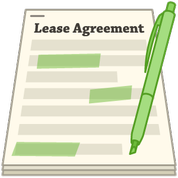 So you’ve found a great apartment, and all you have to do is sign on the dotted line to get your key. Well hold up there, speedy. Think about this: most leases are based on fairly standard documents designed to protect the owner of a property more than the tenant. So taking a few moments to review the details of a lease might prevent some headaches (and expenses) down the road.
So you’ve found a great apartment, and all you have to do is sign on the dotted line to get your key. Well hold up there, speedy. Think about this: most leases are based on fairly standard documents designed to protect the owner of a property more than the tenant. So taking a few moments to review the details of a lease might prevent some headaches (and expenses) down the road.
Don’t overlook the basics
When is your rent due? Is the amount specified in the lease correct? Can you pay online or set up recurring payments? Is there a grace period and/or fees? Are there limits to the number of guests you can have, or the duration of their stay? Where do you park? These are “basic” elements of the lease because they’re the ones that will affect you most. Which means if they’re wonky, they’ll hurt the most. So check them out.
Renewing or ending the lease
Make sure you look into stipulations on when and how to renew or end the lease. Some leases only require 30 days notice, while others demand 90 days or more. If you renew, is there an escalation clause that notes how increases are handled? If you’re moving out, is there a clause about showing the apartment to prospective tenants? Some landlords share keys with real estate professionals eager to find a new tenant, so make sure you understand who can show your apartment, and when. Poker night just isn’t the same when you have strange people walking through your apartment.
Improvements and maintenance
Typically, landlords handle all routine maintenance and repairs, but don’t assume anything. If your deck is getting splintery and the lease states that you have to maintain the finish, you can either kiss those blissful barefoot summer nights goodbye, or fix it yourself.
What about improvements? That hot-pink accent wall really pulls together your kitschy kitchen theme, but when you choose to move out, you might have to paint it back to boring old white (or pay someone else to) if you didn’t get approval first.
The great outdoors
If your new apartment has a great backyard perfect for parties, make sure the lease states that you have the right to use it. For starters, you’ll avoid the embarrassment of getting kicked out of your own party. Also, if that space becomes unusable for any reason (such as a busted sewer pipe requiring the back yard to be dug up), you’ll be eligible for a reduction in your lease. If you can’t use all the space you’ve been allotted, you don’t have to pay for it.
Meet Chuck, my gorilla
Just because the ad stated “pet-friendly apartments,” it doesn’t mean all pets are equal. So let’s imagine for a moment that it’s legal (because it’s awesome) to own a pet gorilla, and you (because you’re awesome) have one. Many leases have weight and/or breed restrictions for pets, and your giant hairy buddy might not be allowed. If you didn’t realize that, Chuck isn’t going to be happy when he’s banned from your new place. And you don’t want to see Chuck when he’s angry.
Getting your security deposit back
We’ve got a great article with tips on how to ensure you’ll get your security deposit back. But in many leases, the landlord is only responsible for returning it within a “reasonable” amount of time. If you want to be sure that “reasonable” doesn’t mean “six months,” you can add a provision to the lease requiring the deposit to be returned within a set timeframe.
In the end, nobody is going to stick up for your interests more than you, so take the time to read the entire lease before you sign it. And if you’re planning a move, you don’t have to go it alone. Moveline](http://www.moveline.com) simplifies the inventory process, gets fair and accurate quotes from reputable movers, and oversees your move from beginning to end. All without costing you a dime. Let us make your move easier than you imagined, freeing you up to spend time on more important things.
 Whether you’d prefer lying on a bed of nails to moving or you’re so excited that you can hardly wait, relocating does give you an excuse to do one really cool thing: take a road trip! If you’re moving to LA, let’s say, from Chicago (or pretty much anywhere between the Midwest and the West Coast), take some time along the way to get your kicks on Route 66!
Whether you’d prefer lying on a bed of nails to moving or you’re so excited that you can hardly wait, relocating does give you an excuse to do one really cool thing: take a road trip! If you’re moving to LA, let’s say, from Chicago (or pretty much anywhere between the Midwest and the West Coast), take some time along the way to get your kicks on Route 66!
There are already a ton of resources dedicated to the sights along The Mother Road, as John Steinbeck called it, and some of the best are here, here, and here. But combing through travel guides is work you can’t be bothered by when you’re busy relocating your life, right? That’s why we’ve done it all for you — just one of the many ways Moveline makes moving delightful.
Sleep & eat on the cheap
Route 66 is chock full of fascinating and affordable accommodations, but there are two standouts:* Belvidere Motel (rooms for just $29 per night!)* Aztec Hotel (a rare instance of Mayan Revival architecture)

Have a gas – no, literally
Blast-from-the-past gas stations pop up along the entire route. Be sure to check out:* Ambler’s Texaco Station* Provone Service Station, aka “The Mother of the Mother Road”* Magnolia Gas Station* U Drop Inn and Tower Station (inspired by a nail in the dirt)

Take the show on the road
Surprisingly, Route 66 is a hidden gem of theater history.* Gillioz Theatre: it has a whopping 100-year lease* 66 Drive-In: the definition of retro-glam* McLain Rogers Amphitheatre: local talent and Broadway-esque productions* Rialto Theatre: elaborately designed to distract from the hard times of the ’30s
The Route concludes in LA, whose Broadway Theatre District consists of 12 historic movie palaces within a six block radius, making it the highest concentration of these elaborate theaters in the world.
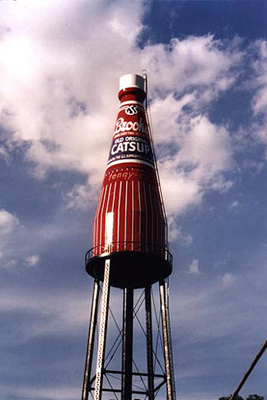
Enjoy some weirdness
Arguably, the best feature of Route 66 is the assortment of unique sights to be seen along the way, such as:* a Totem Pole Park* the world’s largest ketchup bottle water tower* a milk bottle grocery store* a round barn* a bridge with a 22 degree turn in it
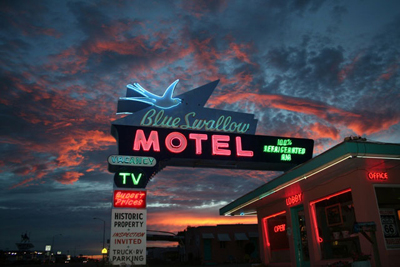
Step back in time
If history is your jam, check out Fort Reno, the Glenrio ghost town, and the Blue Swallow Motel whose sign boasts “100% Refrigerated Air.”
Get back to nature
Nature junkies, never fear. There’s plenty for you as well:* New Mexico’s pueblos and mesas* The Grand Canyon* Petrified Forest National Park* Painted Desert* Mojave National Preserve (which currently runs a stellar artist residency program)* Arizona’s meteor crater* Meramec Caverns
Are you excited? While you’re busy making your Route 66 trip as cool as possible, let Moveline worry about the move itself. We’ll make it more seamless and stress-free than you could ever imagine, helping you choose the right movers at the right price and sticking with you every step of the way. Just be sure to send us a postcard.